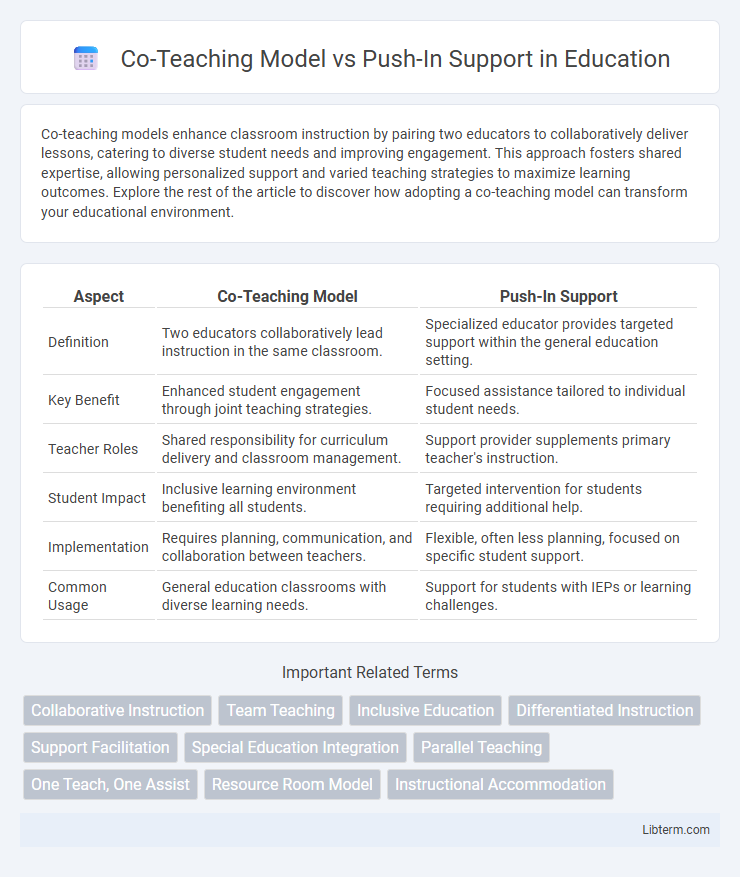Co-teaching models enhance classroom instruction by pairing two educators to collaboratively deliver lessons, catering to diverse student needs and improving engagement. This approach fosters shared expertise, allowing personalized support and varied teaching strategies to maximize learning outcomes. Explore the rest of the article to discover how adopting a co-teaching model can transform your educational environment.
Table of Comparison
| Aspect | Co-Teaching Model | Push-In Support |
|---|---|---|
| Definition | Two educators collaboratively lead instruction in the same classroom. | Specialized educator provides targeted support within the general education setting. |
| Key Benefit | Enhanced student engagement through joint teaching strategies. | Focused assistance tailored to individual student needs. |
| Teacher Roles | Shared responsibility for curriculum delivery and classroom management. | Support provider supplements primary teacher's instruction. |
| Student Impact | Inclusive learning environment benefiting all students. | Targeted intervention for students requiring additional help. |
| Implementation | Requires planning, communication, and collaboration between teachers. | Flexible, often less planning, focused on specific student support. |
| Common Usage | General education classrooms with diverse learning needs. | Support for students with IEPs or learning challenges. |
Introduction to Inclusive Education Strategies
Co-Teaching Model involves two educators sharing instructional responsibilities to support diverse learners within the same classroom, promoting collaboration and differentiated instruction. Push-In Support entails specialists providing targeted assistance within the general education environment, allowing students to access specialized resources without leaving the classroom. Both strategies enhance inclusive education by fostering engagement, reducing segregation, and addressing individual learning needs effectively.
Defining the Co-Teaching Model
The Co-Teaching Model involves two educators collaboratively delivering instruction within the same classroom, sharing responsibilities for planning, teaching, and assessing students. This approach promotes differentiated instruction by leveraging each teacher's expertise to meet diverse student needs simultaneously. It differs from Push-In Support, where a specialist provides targeted assistance primarily without joint lesson delivery or shared instructional control.
Understanding Push-In Support
Push-in support involves special education teachers or specialists entering general education classrooms to provide targeted assistance to students with disabilities while maintaining inclusive learning environments. This model promotes real-time collaboration between educators, fostering immediate intervention and differentiation without removing students from the core instructional setting. Understanding push-in support highlights its emphasis on accessibility, peer interaction, and seamless integration within the general education curriculum.
Key Differences Between Co-Teaching and Push-In Support
Co-Teaching Model involves two educators collaboratively planning, delivering, and assessing instruction within the same classroom, promoting shared responsibility and active engagement of all students. Push-In Support typically features a specialist entering a general education classroom to provide targeted assistance, focusing mainly on individualized student needs without joint lesson planning. The key difference lies in collaboration depth: co-teaching requires co-planning and co-instruction by both teachers, while push-in support offers supplementary help without equal partnership in teaching.
Roles and Responsibilities of Educators
In the Co-Teaching Model, general and special education teachers collaborate by jointly planning, delivering, and assessing lessons within the same classroom, sharing equal responsibility for all students' learning outcomes. Push-In Support involves a special education teacher providing targeted assistance to individual students or small groups within the general classroom while the primary teacher maintains overall instructional leadership. Clear delineation of roles ensures effective communication, with co-teachers co-managing lesson design and delivery, whereas push-in specialists focus on tailored interventions without assuming full classroom instructional control.
Impact on Student Learning Outcomes
The Co-Teaching Model enhances student learning outcomes by fostering collaboration between general and special education teachers, resulting in differentiated instruction that meets diverse learner needs. Push-In Support provides targeted assistance within the general classroom, improving access to curriculum but may limit intensive, personalized intervention. Studies indicate Co-Teaching often yields higher engagement and academic achievement, particularly for students with disabilities, due to its integrated and interactive instructional approach.
Collaboration and Communication Strategies
The Co-Teaching Model fosters collaboration through shared lesson planning, joint instruction, and continuous dialogue between general and special education teachers, enhancing student engagement and learning outcomes. Push-In Support emphasizes real-time communication strategies, allowing special educators to provide targeted assistance within the general classroom without disrupting the instructional flow. Both models rely on structured collaboration and clear communication channels to address diverse student needs effectively.
Challenges in Implementation
Co-Teaching Model faces challenges such as scheduling conflicts, inconsistent collaboration between general and special education teachers, and difficulty in aligning instructional strategies. Push-In Support struggles with maintaining student engagement in inclusive settings and balancing individualized attention within a crowded classroom environment. Both models require ongoing professional development and strong communication to overcome barriers in effectively meeting diverse learner needs.
Best Practices for Classroom Effectiveness
Co-teaching model promotes shared instructional responsibilities between general and special educators, leading to differentiated instruction and increased student engagement through collaborative lesson planning and delivery. Push-in support offers targeted assistance by special educators within the general classroom, enhancing inclusivity without removing students from mainstream settings. Best practices emphasize consistent communication, aligned goals, and adaptive strategies to maximize instructional effectiveness and meet diverse learners' needs.
Choosing the Right Model for Your School
Selecting the right instructional support model depends on your school's specific needs, resources, and student population. Co-Teaching Model promotes collaboration between general and special education teachers, fostering inclusive learning environments and shared responsibility. Push-In Support offers targeted assistance within the general classroom, ideal for schools seeking flexibility and direct service to students without removing them from core instruction.
Co-Teaching Model Infographic

 libterm.com
libterm.com